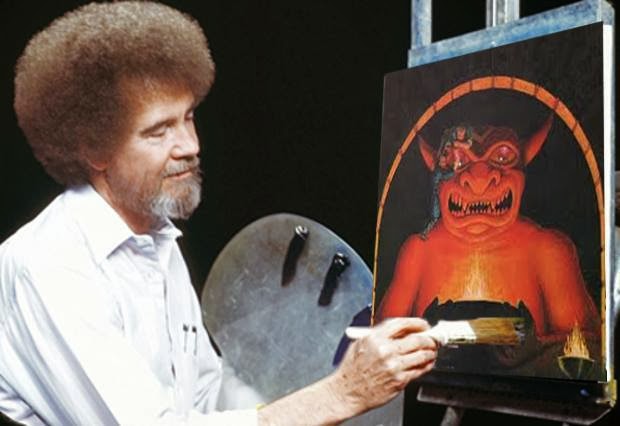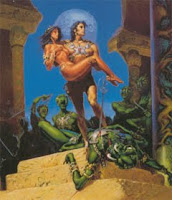Pop culture reference. Again.
Novelist/ screenwriter (and so many more titles it makes me green with envy) Clive Barker once commented that a great monster can save the ending of almost any movie. Granted, he was saying this to explain an odd affection for Howard the Duck, but it’s still a solid point. An ending can make or break a story. A so-so film with a phenomenal ending will usually get favorable reviews. A strong manuscript that spirals downward at the end will, more often than not, be tossed in the large pile on the left.
Now, bad endings don’t always have the same root problem. Sometimes a weak ending happens when people have a really cool idea for a story, but don’t know what to do with it past that initial idea. Perhaps the writer had a phenomenal way to start a film or novel, but wasn’t sure how to wrap it up. What is certain is that there are some endings that almost always don’t work, no matter what.
Note that I said almost always. As I go through this list, you’ll probably be able to name some books or films that use one of these endings very successfully. I’ll even name a few of them myself as we go along. For one reason or another, though, these endings are exceptionally difficult to pull off.
So, keeping that in mind, let’s go over seven of the standard bad endings
Everybody Dies and the Antagonist Wins—Hard to believe that after centuries of storytelling this is still considered an unsatisfying ending, I know. One of the biggest problems with wrapping things up this way is it gives the reader a sense that the story was pointless. They’ve just invested a few hours (or perhaps days) of their time into this tale only to see it come to an unpleasant ending. This can be even more frustrating if any of the characters made foolish decisions somewhere along the way. After all, it’s bad enough when you have to watch the fifth person in a row walk through the archway marked Painful Death, but when that’s the point the writer chooses to end the story on…?
Your protagonist doesn’t need to come through unscarred, mind you. Heck, you can even get away with killing your lead (The Dead Zone comes to mind). But they still need to win.
The Left Fielder—Called such because it’s the ending that comes out of nowhere. The office slacker finally gets his act together, saves his friends, gets the girl—and then gets hit by a bus as he steps off the curb. The crack whore decides to go straight and get out so she can raise her little girl, but then the preschooler gets into the bottles under the sink and drinks five gallons of bleach. In my experience, the vast majority of writers who use this kind of ending are trying to achieve art. It’s an attempt to show how random and meaningless life can be by having a random and meaningless ending.
Besides suffering from all the same frustration issues as the previous ending, the left fielder just isn’t that special anymore. It’s become one of the most common conclusions in indie films and “literature.” So besides exasperating an audience, it’s an ending they’re probably going to see coming for the simple reason it wouldn’t be what they’d expect.
There is nothing wrong, shameful, or pedestrian with putting the right ending on a story. Notice that nobody got hit by a train at the end of Slumdog Millionaire yet it was still well-received.
Nothing Changes—Pretty straightforward. If the first ten pages and the last ten pages show the characters in the same place, doing the same things, with the same people, and they’re not any wiser for the experience… well, that’s not much of an experience, is it? For them or for the audience. Even if people don’t have some huge emotional growth or breakthrough, there has to be something notably different or this was just more wasted time.
One type of story that does this a lot is the “slice of life” tale. Just two or three average days in the life of two or three average people. Now, yes, most of our lives don’t change radically in any given moment. Most of what I’m doing today is what I did yesterday and what I’ll probably do tomorrow. So, yes, it would be a truthful ending if a slice of life story about me ended with me back here at my desk where I am most every day.
The question you need to ask yourself is, why would anyone want to read about that? I know I sure wouldn’t. I go through a slice of life every day where nothing changes. I want to be entertained!
…And They Write a Book/ Screenplay About the Experience—I’ve mentioned before that this is, hands down, the worst ending you can have for a screenplay. It isn’t much better in a book. This is almost always a tacked on ending to assure the audience the protagonist didn’t just survive this story—they benefited from it. A lot. Yeah, you would think kicking drugs, reconnecting with the family, and getting the girl/boy would be plenty of reward for most folks, but noooooooo…
In my experience, writers tend to fall back on this ending for one of three reasons (sometimes more than one of them). One is a desire to add that patina of reality to the story, thus making it more valid somehow. Two is that it falls into that silly “write what you know” tip we’ve all heard for years and years. Third is that it’s sort of a wish-fulfillment validation. If Yakko writes a story about surviving the zombie attack and it becomes a bestselling novel/ Oscar-winning film… well, logically, when I write a story about Yakko writing a story about surviving a zombie attack my work will also be worthy of such success and validation.
There’s a medical term for this. It usually involves lots of therapy and certain prescription medications.
The Y’see Timmy—If you’ve never seen it, go watch Speechless (written by Robert King), where Michael Keaton does a better job explaining this idea to Geena Davis than I’m ever going to manage with you folks. Plus it’s just a fun movie.
This ending gets its name from the old Lassie television show. Little Timmy would encounter some problems, work his way out of them, and at the end Mom would sit him down and explain what happened and why. “Y’see, Timmy, sometimes people get hurt inside and it never heals…” Timmy and the audience learn a little something about life and we all go home as better, happy people.
Alas, in inexperienced hands the Y’see Timmy quickly becomes “beating your audience over the head with a blunt line of dialogue or three.” If you’ve ever made your way through Ayn Rand’s Atlas Shrugged, you probably remember the 98 page monologue at the end which recaps every one of the subtle lessons that were shown in the first 800 pages of the book. You also probably ended up skimming the monologue, just like everyone else did.
If the moral of the story is clear, do you need to explain it to your audience again? If it isn’t that clear, then the problem isn’t your ending, is it? Go watch Gattaca, which actually manages an amazing double-Y’see Timmy.
It Was All a Dream—All too often the amazing tale of adventure ends with one of the heroes waking up on the couch or in a hospital bed. No, none of the story the audience has just invested their time and attention in really happened, not even in the world of the story. We all just put ourselves into a story about a person who was putting themselves into a story.
Now, there was a time when this ending was daring, new, and caught people off guard. For the record, that time was 1890 when Ambrose Bierce sold his short story “An Occurrence at Owl Creek Bridge.” Since then it’s been used once or thrice in literature and about a billion times since the creation of the sitcom. Was there anyone who went to see Click who didn’t immediately say “it’s all going to be a dream!!” the moment Adam Sandler stretched out on that Bed Bath & Beyond display? Think about it—it’s such a common ending most folks could spot the moment the dream began.
I could recommend one or two great dream sequence films, but that would kind of ruin the point, wouldn’t it…?
The Wedding—There are a few reasons weddings can make folks yawn at the end of a story. Right off the bat, it’s such a ridiculously common ending. Much like the artsy Left Fielder, so many writers have taken to ending their romances or rom-coms with a wedding it’s become the default, which means it’s far too common to use in any other genre. Also, a wedding tends to clarify timelines in a story, which is not always a good thing. It can either emphasize that these folks are getting married less than a month after meeting each other, or it can point out that the narrative just skipped seven or eight months between pages, which emphasizes that this is just a tacked on ending.
Really, the only thing worse then just ending on a wedding is when your real ending is something completely outlandish and ridiculous on its own–say, for example, having your hero return a crystal skull to a Mesoamerican flying saucer–and then you tack on the wedding as a complete afterthought so you can hint at a spin-off.
But maybe that’s just my opinion…
So, there they are, seven endings that were tired and worn out long before Isaac Asimov ever heard the word “robot” or Edgar Rice Burroughs thought apes in Africa might be able to raise a human child. Like many of the tips I toss out, I’m not saying it’s impossible to do one of these. It is very, very difficult, though, and you may want to think twice before tackling one of them.
Next week, we’ll try to settle that age-old problem that’s kept scholars, philosophers, and savants awake at night for many years of their lives. Who would win in a fight—Jean Grey from X-Men or Tia from Escape to Witch Mountain?
Before that, though, you have more writing to do. So get to it.
 All starting with action means is that I need something to happen. Being fired from my job (or written up, or promoted) is action. Getting beaten up (or asked out) by the quarterback in high school is something happening. Buying groceries is something happening.
All starting with action means is that I need something to happen. Being fired from my job (or written up, or promoted) is action. Getting beaten up (or asked out) by the quarterback in high school is something happening. Buying groceries is something happening. A lot of folks stumble into this trap. They “start with action” (see above) by having a bunch of nameless, unimportant people get killed by some threat, and then they introduce their actual charactersand get on with the story. Which tells right me there that those opening bits are just more wasted pages.
A lot of folks stumble into this trap. They “start with action” (see above) by having a bunch of nameless, unimportant people get killed by some threat, and then they introduce their actual charactersand get on with the story. Which tells right me there that those opening bits are just more wasted pages.




